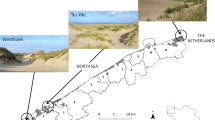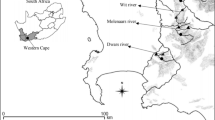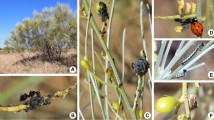Abstract
The presence of the exotic Argentine ant, Linepithema humile Mayr (Hymenoptera: Dolichoderinae), nitrogen enrichment, and early-season herbivory by the specialist beetle Trirhabda bacharidis (Coleoptera: Chrysomelidae) have been shown, through separate experiments, to affect the densities of insect herbivores of the coastal shrub Baccharis halimifolia (Asteraceae), in Florida. Using a fully-factorial field experiment, we examined the relative importance of all three of these factors to the six most common insect herbivore species utilizing this host plant in a West Central Florida coastal habitat. The presence of ants affected more herbivore species than either early-season herbivory by larval T. bacharidis or nitrogen enrichment. Experimental reductions of L. humile resulted in reductions of an aphid, its coccinellid predators, and adult T. bacharidis, and increases of two species of leafminers and one species of stemborer. Due to the strong negative effects of stemborer herbivory on host plant survival, the increase in stemborer abundance led to increased host plant mortality. Early-season herbivory by larval T. bacharidis only affected the abundance of aphids and their predators, both of which were more abundant on trees with reduced early-season herbivory. Nitrogen fertilization had the most limited effects and only T. bacharidis larvae achieved higher densities on fertilized trees. Our results indicate that aphid tending by the exotic L. humile affects other insects on B. halimifolia more so than herbivory by the exploitative competitor T. bacharidis or nitrogen as a limiting nutrient.





Similar content being viewed by others
References
Altfeld L, Stiling P (2006) Argentine ants strongly affect some but not all common insects on Baccharis halimifolia. Environ Entomol 35(1):31–36
Awmack CS, Leather SR (2002) Host plant quality and fecundity in herbivorous insects. Annu Rev Entomol 47:817–844
Boldt PE (1989) Biology and host specificity of Trirhabda bacharidis (Coleoptera: Chrysomelidae) on Baccharis (Asteraceae: Asteraceae). Environ Entomol 18:78–84
Buckley RC (1987) Interactions involving plants, homoptera, and ants. Annu Rev Ecol Syst 18:111–135
Cole FR, Medeiros AC, Loope LL et al (1992) Effects of the Argentine ant on arthropod fauna of Hawaiian high-elevation shrubland. Ecology 73:1313–1322
Davidson DW, Cook SC, Snelling RR (2004) Liquid-feeding performances of ants (Formicidae): ecological and evolutionary implications. Oecologia 139:255–266
Del-Claro K, Oliveira PS (2000) Conditional outcomes in a neotropical treehopper-ant association: temporal and species-specific variation in ant protection and homopteran fecundity. Oecologia 124:156–165
Denno RF, McClure MS, Ott JR (1995) Interspecific interactions in phytophagous insects: competition reexamined and resurrected. Annu Rev Entomol 40:297–331
Denno RF, Peterson MA, Gratton C et al (2000) Feeding-induced changes in plant quality mediate interspecific competition between sap-feeding herbivores. Ecology 81:1814–1827
Evans EW, Dixon AFG (1986) Cues for oviposition by ladybird beetles (Coccinellidae): response to aphids. J Anim Ecol 55:1027–1034
Faeth SH (1980) Invertebrate predation of leaf-miners at low densities. Ecol Entomol 5:111–114
Fagundes M, Neves V, Fernandes GW (2005) Direct and indirect interactions involving ants, insect herbivores, parasitoids, and the host plant Baccharis dracunculifolia (Asteraceae). Ecol Entomol 30:28–35
Forkner RE, Hunter MD (2000) What goes up must come down? Nutrient addition and predation pressure on oak insects. Ecology 81:1588–1600
Fowler SV, MacGarvin M (1985) The impact of hairy wood ants, Formica lugubris, on the guild structure of herbivorous insects on birch, Betula pubescens. J Anim Ecol 54:847–855
Hacker SD, Bertness MD (1995) A herbivore paradox: why salt marsh aphids live on poor-quality plants. Am Nat 145:192–210
Holway DA, Lach L, Suarez AV et al (2002) The causes and consequences of ant invasions. Annu Rev Ecol Syst 33:181–233
Hudson EE, Stiling P (1997) Exploitative competition strongly affects the herbivorous insect community on Baccharis halimifolia. Oikos 79:521–528
Hunter MD, Price PW (1992) Playing chutes and ladders: heterogeneity and the relative roles of bottom-up and top-down forces in natural communities. Ecology 73:724–732
Huxel GR (2000) The effect of the Argentine ant on the threatened valley elderberry longhorn beetle. Biol Invasions 2:81–85
Kaplan I, Eubanks MD (2005) Aphids alter the community-wide impact of fire ants. Ecology 86:1640–1649
Kytö M, Niemela P, Larsson S (1996) Insects on trees: population and individual response to fertilization. Oikos 75:148–159
Mahdi T, Whittaker JB (1993) Do birch trees (Betula pendula) grow better if foraged by wood ants? J Anim Ecol 62:101–116
Mattson WJ (1980) Herbivory in relation to plant nitrogen content. Annu Rev Ecol Syst 11:119–161
Moe SJ, Stelzer RS, Forman MR et al (2005) Recent advances in ecological stoichiometry: insights for population and community ecology. Oikos 109:29–39
Moon DC, Stiling P (2002) Top-down, bottom-up, or side to side? Within-trophic-level interactions modify trophic dynamics of a salt marsh herbivore. Oikos 98:480–490
Moon DC, Stiling P (2004) The influence of a salinity and nutrient gradient on coastal vs. upland tritrophic complexes. Ecology 85:2709–2716
Murdoch WW, Luck RF, Swarbrick SL et al (1995) Regulation of an insect population under biological control. Ecology 76:206–217
Ness JH, Bronstein JL (2004) The effects of invasive ants on prospective ant mutualists. Biol Invasions 6:445–461
Pezzolesi LSW, Hager BJ (1994) Ant predation on two species of birch leaf-mining sawflies. Am Midl Nat 131:156–168
Sanders NJ, Gotelli NJ, Heller NE et al (2003) Community disassembly by an exotic species. Proc Natl Acad Sci 100:2474–2477
Sih A, Crowley P, McPeek M et al (1985) Predation, competition, and prey communities: a review of field experiments. Annu Rev Ecol Syst 16:269–311
Skinner GJ, Whittaker JB (1981) An experimental investigation of inter-relationships between the wood-ant (Formica rufa) and some tree-canopy herbivores. J Anim Ecol 50:313–326
Sloggett JJ, Majerus MEN (2000) Aphid-mediated coexistence of ladybirds (Coleoptera: Coccinellidae) and the wood ant Formica rufa: seasonal effects, interspecific variability and the evolution of a coccinellid myrmecophile. Oikos 89:345–359
Styrsky JD, Eubanks MD (2007) Ecological consequences of interactions between ants and honeydew-producing insects. Proc R Soc B 274:151–164
Suzuki N, Ogura K, Katayama N (2004) Efficiency of herbivore exclusion by ants attracted to aphids on the vetch Vicia angustifolia L. (Leguminosae). Ecol Res 19:275–282
Van Zandt PA, Agrawal AA (2004) Community-wide impacts of herbivore-induced plant responses in milkweed (Asclepias syriaca). Ecology 85:2616–2629
Viswanathan DV, Narwani AJT, Thaler JS (2005) Specificity in induced plant responses shapes patterns of herbivore occurrence on Solanum dulcamara. Ecology 86:886–896
Way MJ, Khoo KC (1992) Role of ants in pest management. Annu Rev Entomol 37:479–503
Way MJ, Paiva MR, Cammell ME (1999) Natural biological control of the pine processionary moth Thaumetopoea pityocampa (Den. & Schiff.) by the Argentine ant Linepithema humile (Mayr) in Portugal. Agric For Entomol 1:27–31
Wimp GM, Whitham TG (2001) Biodiversity consequences of predation and host plant hybridization on an aphid-ant mutualism. Ecology 82:440–452
Zar JH (1999) Biostatistical analysis. Prentice Hall, Upper Saddle River
Acknowledgements
We thank Sylvia Lukasiewicz for help with field work, Robert Browning and Jim Wilson at Fort De Soto Park for use of the field site. This work was funded by NSF grant DEB 03-15190.
Author information
Authors and Affiliations
Corresponding author
Rights and permissions
About this article
Cite this article
Altfeld, L., Stiling, P. Effects of aphid-tending Argentine ants, nitrogen enrichment and early-season herbivory on insects hosted by a coastal shrub. Biol Invasions 11, 183–191 (2009). https://doi.org/10.1007/s10530-008-9223-4
Received:
Accepted:
Published:
Issue Date:
DOI: https://doi.org/10.1007/s10530-008-9223-4




